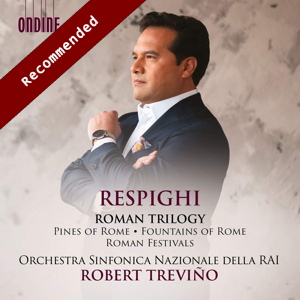
Ottorino Respighi (1879-1936)
Roman Trilogy
Fountains of Rome (1916)
Roman Festivals (1928)
Pines of Rome (1924)
Orchestra Sinfonica Nazionale Della RAI/Robert Treviño
rec. 2022, Turin, Italy
Ondine ODE1425-2 [66]
First on the disc come Fountains of Rome. Conductor Robert Treviño paces the work superbly. The two faster inner movements do not sound rushed, so the Trevi Fountain can take its time to reach an overpowering climax. Percussion has a heyday, underpinned by the organ pedals giving a fine contrast to the quiet, beautifully delicate impressionism of the Villa Medici final movement.
I had rather expected to be somewhat dismissive of Roman Festivals, often just described as noisy. Well, it is noisy, but such is the colourful splendour of this recording, and the orchestra’s truly virtuoso playing, that I found myself becoming engrossed in admiration of Respighi’s mastery of orchestration. Thanks to the detailed booklet notes, I was able to follow the various aspects of the festivals that the composer has illustrated. It is not all just noise, not by any means. Take, for example, the closing section of the third movement The October Harvest.A sweeping violin melody represents a Roman love song capturing the mood of the day. It is softly followed by clarinet and horn, and then a mandolin enters for a romantic serenade. Finally, sleigh bells ring as the horses working to gather the harvest make their way home. The recording is exceptional here, as it is towards the end of the second movement The Jubilee: pilgrims climb a hill to see the Holy City come into view, and church bells sound. Again, the composer’s vivid orchestral imagination makes this a stand-out section for me. Even in some of the most heavily scored passages, the recording manages to enable us to hear individual voices in Respighi’s enormous orchestra, without any obvious spotlighting.
Finally, my favourite of the Trilogy, The Pines of Rome. I confess I immediately jumped to the last movement, The Pines of the Appian Way, where Respighi treats us to a memorable march which represents the tread of triumphant legions approaching Roma Eterna. The percussion-led march, at first soft, gradually increases in volume and orchestral complexity, rising to a tumultuous tam-tam and organ-capped climax. It is a truly outstanding orchestral feast for the ears.
The Fritz Reiner/Chicago Symphony 1959 recording – especially in its SACD remastering (RCA 82876-71614-2) – is still a remarkable document. Still, even its sonic splendours are hard pushed to match this recording, although the performance remains peerless.
The production standards for his disc are of the highest, and I have already mentioned the truly spectacular recording. The booklet, in English only, discusses the works at some length, and has information about the orchestra and the conductor.
Jim Westhead
Help us financially by purchasing from





















